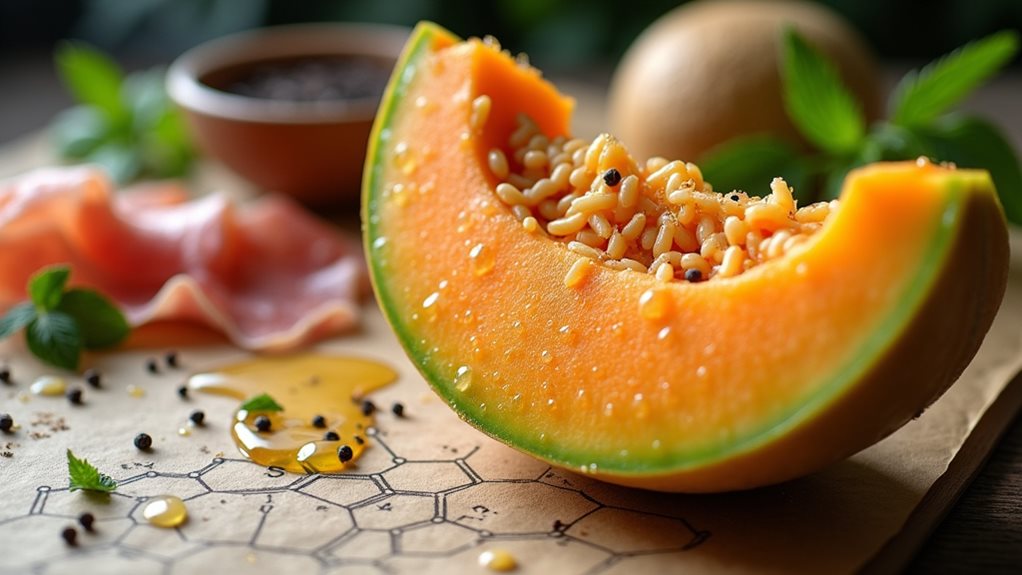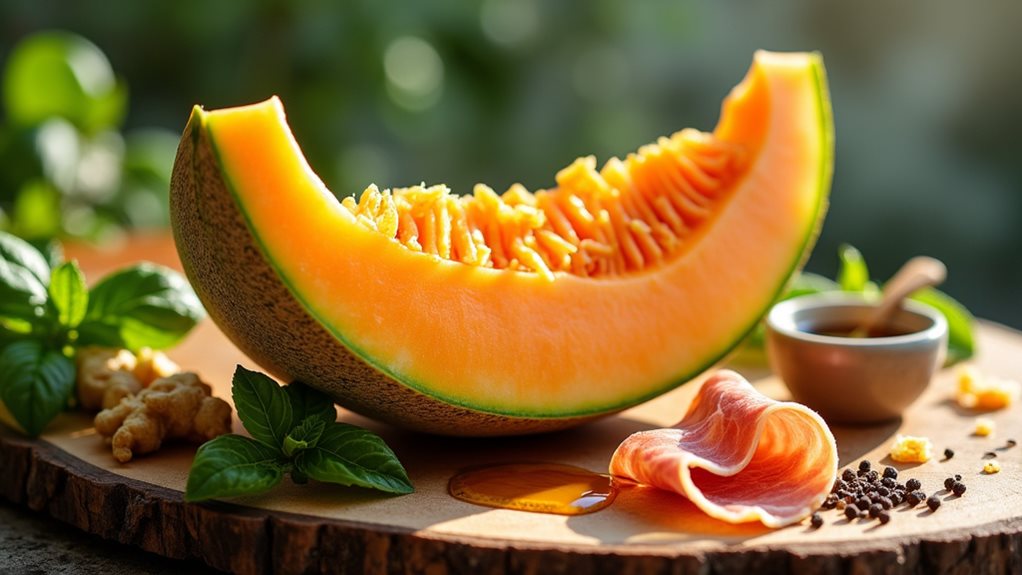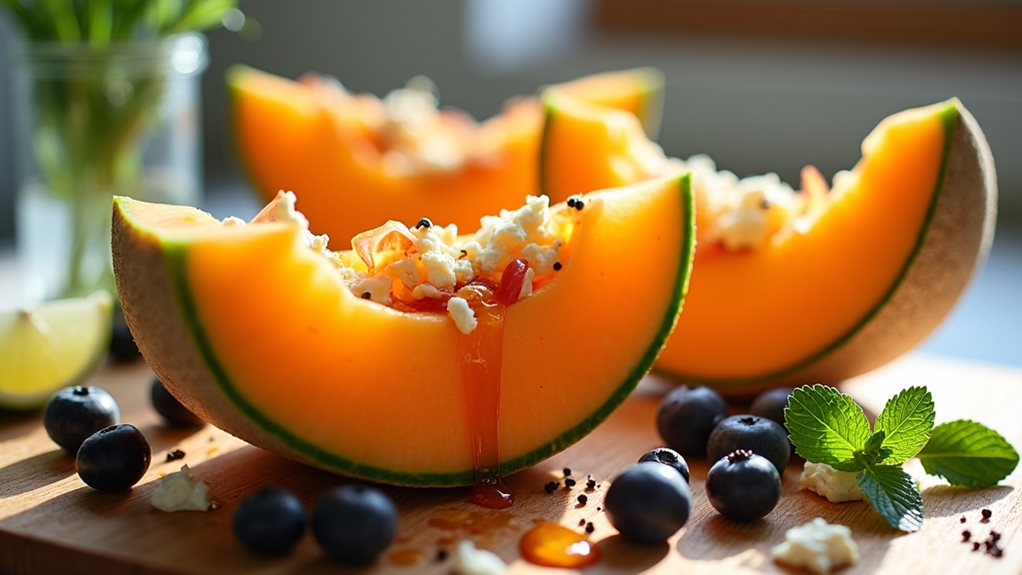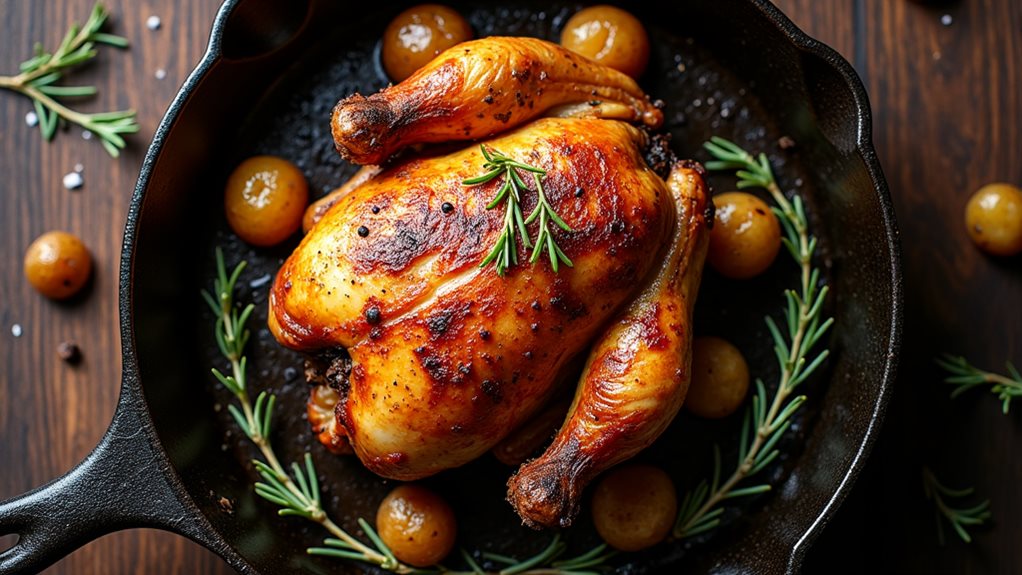Cantaloupe pairs perfectly with salty prosciutto, creating a classic sweet-savory balance. You'll find it complements aromatic herbs like mint, basil, and tarragon, while spices such as black pepper and chili powder add unexpected depth. Try combining it with creamy cheeses like stracciatella or goat cheese for luxurious contrast. For beverages, blend cantaloupe with gin or vodka and add fresh lime and mint. These combinations highlight cantaloupe's naturally sweet, floral profile while creating sophisticated flavor experiences.
The Aromatic Chemistry Behind Cantaloupe Pairings

When you bite into a perfectly ripe cantaloupe, you're experiencing a complex symphony of volatile compounds that create its distinctive flavor profile.
The cantaloupe aroma comes from a combination of 86 known compounds and 53 newly identified ones, primarily esters and aldehydes that develop during ripening.
The complex tapestry of cantaloupe flavor unfolds through 139 compounds—each ester and aldehyde contributing to nature's perfect ripening process.
Understanding these compounds opens doors to innovative pairings. Through Solid Phase Microextraction (flavor extraction), scientists have mapped how cantaloupe's sweet, floral notes interact with other ingredients.
You'll find that lime enhances the fruit's invigorating qualities, while coconut complements its underlying sweetness. Adding cucumber creates a refreshing sweetness that elevates both ingredients' natural profiles.
The chemistry behind these successful pairings isn't random—it's based on how volatile compounds interact at palate temperature, creating harmonious flavor experiences that can transform your culinary creations from ordinary to extraordinary. Research shows that ester compounds, which contribute significantly to cantaloupe flavor, tend to increase post-pollination and peak with optimal harvest maturity.
Classic Mediterranean Cantaloupe and Prosciutto
The quintessential Mediterranean pairing of cantaloupe and prosciutto represents one of gastronomy's most perfect marriages of flavor and texture.
Dating back nearly 3,000 years, this combination showcases the beautiful simplicity of Mediterranean cuisine where flavor contrasts create culinary magic.
When preparing this classic dish, remember these four essential elements:
- Select perfectly ripe cantaloupe – its sweetness should counterbalance the prosciutto's saltiness
- Use high-quality prosciutto – authentic Prosciutto di Parma or San Daniele offers the best prosciutto origins and flavor profile
- Consider texture contrasts – the soft, juicy melon against paper-thin cured ham creates sensory delight
- Enhance with complementary elements – try drizzling with honey or balsamic glaze for modern interpretation
The traditional approach often features ripe cantaloupe wedges wrapped in thin slices of prosciutto for an elegant presentation.
You'll find this combination works brilliantly as an appetizer or light summer meal.
For a more elaborate presentation, you can create a stunning salad with melon balls and torn pieces of creamy burrata.
Herb and Spice Symphonies for Cantaloupe

Your journey into cantaloupe's flavor potential continues with an exploration of herbs and spices that transform this already delicious fruit.
You'll find that aromatic herbs like mint, basil, and tarragon create invigorating contrasts with cantaloupe's natural sweetness, while warming spices such as cinnamon, cardamom, and ginger add depth and complexity to each bite. Similar to the way modernist literature explored culinary experiences, cantaloupe provides a canvas for sensory exploration that transcends simple consumption.
Whether you're sprinkling a pinch of black pepper for a classic enhancement or experimenting with more adventurous options like Tajin or chili powder, these flavor symphonies will elevate your cantaloupe experience beyond the ordinary. In many Latin American culinary traditions, cantaloupe is often served with chili-based spices that highlight the melon's refreshing sweetness.
Aromatic Herb Blends
Harmonious herb combinations transform ordinary cantaloupe into extraordinary culinary experiences, elevating this sweet melon to new heights of flavor complexity.
Understanding herb profiles is essential when crafting these blends, as each herb contributes unique characteristics that enhance cantaloupe's natural sweetness.
For maximum flavor enhancement, try these aromatic combinations:
- Basil, mint, and cilantro create a revitalizing summer blend that balances the melon's sweetness with herbaceous notes.
- Tarragon and thyme offer an earthy complexity that deepens cantaloupe's flavor profile.
- Mediterranean herbs like oregano and marjoram add savory dimensions to contrast with the fruit's juicy sweetness.
- Lemongrass and lemon verbena infuse citrus undertones that brighten and amplify cantaloupe's natural freshness.
These herb pairings can be especially effective as they accentuate the honeyed sweetness of cantaloupe while creating delightful flavor contrasts.
Professional chefs often rely on flavor compounds shared between ingredients to create these unexpected yet harmonious combinations.
Drizzling a herb-infused oil over cantaloupe slices offers a sophisticated way to enhance both presentation and taste, similar to the technique used in the Melon Caprese Salad.
Warming Spice Profiles
While aromatic herbs bring freshness to cantaloupe, warming spices introduce depth and complexity that transform this humble melon into a sophisticated culinary experience.
You'll discover remarkable flavor enhancement through strategic spice blends that highlight cantaloupe's natural sweetness.
Try cardamom and paprika for an exotic touch, or enhance the melon's sweetness with black pepper, a classic Southern approach. Recent experimentation revealed that a perfectly ripe cantaloupe provides the ideal canvas for these flavor combinations. Nutmeg's woody notes can significantly intensify the natural sweetness of cantaloupe slices. For holiday-inspired treats, cinnamon and cloves create warm, spicy depth.
Don't overlook global inspirations—Mexican Tajin adds chili-lime excitement, while Indian cardamom brings aromatic intensity.
For maximum impact, consider contrasting effects: sea salt balances sweetness, while smoked paprika introduces savory dimensions.
These warming spices aren't limited to raw presentations—they excel in desserts, marinades, beverages, and preserves, expanding your cantaloupe repertoire greatly.
Cheese and Dairy Companions for Sweet Melons
The delicate sweetness of cantaloupe creates a perfect canvas for dairy pairings, especially when contrasted with the right cheese selection.
Creamy options like stracciatella offer a luxurious complement that enhances the melon's natural flavors without overwhelming them.
For your next cantaloupe cheese adventure, try these sophisticated combinations:
- Pair torn stracciatella with cantaloupe chunks, drizzled with honey and fresh mint
- Layer thin slices of manchego between cantaloupe for a nutty-sweet balance
- Crumble tangy goat cheese over a cantaloupe salad with arugula and balsamic
- Create a revitalizing dessert by topping cantaloupe with Greek yogurt and crushed pistachios
The textural contrast between firm cantaloupe and soft cheeses creates a sensory experience that transforms this humble fruit into an innovative culinary statement.
Seasonal Melon Medleys and Fruit Combinations

Creating a vibrant seasonal melon medley requires understanding how different fruits complement cantaloupe's distinctive sweetness and texture.
Pair cantaloupe with honeydew and watermelon for a classic combination that balances sweet and invigorating flavors. For more complex melon medley contrasts, introduce Piel de Sapo or Crenshaw varieties to diversify your palette.
Enhance your seasonal fruit combinations by considering texture variations. Add crunch with toasted nuts, introduce creaminess with crème fraîche, or create savory notes with thinly sliced prosciutto.
Fresh herbs like mint or basil contribute aromatic elements while citrus dressings amplify the natural sweetness without overwhelming.
Serve your medley chilled for maximum invigoration in summer, or shift to fall by incorporating pomegranate seeds and a light sprinkle of cinnamon for an unexpected seasonal twist.
Cantaloupe in Summer Beverages and Cocktails
Summer heat calls for invigorating cantaloupe beverages that quench thirst while delivering complex flavor profiles.
When crafting cantaloupe cocktails, you'll find this versatile melon transforms ordinary drinks into summer refreshment masterpieces, especially when paired with complementary spirits and herbs.
- Spirit Selection – Experiment with gin for botanical notes, tequila for vibrant intensity, or vodka for a clean base that lets cantaloupe shine.
- Texture Techniques – Blend for smoothness or add melon balls for visual appeal and textural contrast.
- Flavor Enhancers – Balance sweetness with lime juice while introducing mint or basil for aromatic complexity.
- Serving Strategy – Chill glasses beforehand and strain blended mixtures for clarity; perfect for outdoor gatherings where hydration meets sophistication.
Global Cantaloupe Recipes Worth Discovering
You'll find cantaloupe elevated to new heights in Middle Eastern traditions, where it's often paired with sumac and pomegranate for a sweet-tart complexity that transforms the humble melon.
Asian cantaloupe innovations showcase the fruit's versatility in unexpected applications like vegan sushi rolls and spicy kimchi variations that challenge Western palates.
Mediterranean inspirations, particularly the classic Italian pairing of cantaloupe with prosciutto, demonstrate how the melon's sweetness can be beautifully balanced with salt and umami flavors.
Middle Eastern Melon Traditions
Throughout the Middle East, cantaloupe traditions stretch back centuries, revealing a rich tapestry of flavor combinations that you'll rarely find in Western cuisine.
The cultural significance of melons extends beyond mere nourishment—they symbolize hospitality and abundance in Middle Eastern melon traditions.
Try these authentic Middle Eastern cantaloupe pairings:
- Drizzle cantaloupe with honey and sprinkle with chopped pistachios or almonds for a simple yet elegant dessert.
- Combine cantaloupe with fresh mint and a touch of cinnamon for a revitalizing summer treat.
- Explore the Bedouin technique of roasting young melons with chili peppers for a surprisingly complex flavor profile.
- Pair cantaloupe with salty cheese, mimicking regional practices that balance sweet and savory notes.
Asian Cantaloupe Innovations
While Middle Eastern traditions honor cantaloupe with time-tested combinations, Asia's approach to this versatile melon reveals a fascinating blend of innovation and tradition.
You'll discover a world of unexpected pairings when you explore spicy cantaloupe desserts featuring ginger, soy sauce, and aromatic mint.
Try crafting cantaloupe salads with cooling cucumber, zesty lime, and fiery chili peppers—a signature combination that balances sweetness with heat.
For an invigorating twist, pair cantaloupe with Korean gochugaru or combine it with Fuji apples for textural contrast. The melon's natural sweetness works beautifully alongside traditional Asian ingredients, creating vibrant summer dishes that cool and satisfy.
Though not historically central to Asian cuisine, cantaloupe has found its place in modern fusion recipes, offering you exciting new ways to enjoy this juicy fruit.
Mediterranean Melon Inspirations
Mediterranean cuisine has elevated the humble cantaloupe to spectacular heights by pairing it with ingredients that enhance its natural sweetness while creating memorable flavor contrasts.
You'll find these invigorating dressings and cantaloupe garnishes transform simple melons into culinary masterpieces.
Try these Mediterranean-inspired combinations:
- Combine diced cantaloupe with cucumber, feta, and mint, finishing with a honey-lemon dressing for a cooling summer salad.
- Pair cantaloupe with za'atar and red onion for a Middle Eastern twist that balances sweet with aromatic spice.
- Layer cantaloupe with prosciutto and drizzle with olive oil for a classic appetizer that's both elegant and simple.
- Create a spicy cantaloupe salad with cayenne-infused dressing, balancing heat against the melon's natural sweetness.
Unexpected Savory Pairings That Surprise the Palate
Beyond the familiar pairing of prosciutto and cantaloupe, there's a world of unexpected savory combinations waiting to transform your perception of this sweet melon.
Try drizzling high-quality olive oil over cantaloupe chunks for an elegant appetizer that balances fruit and fat perfectly. The surprising pairings don't stop there—experiment with tangy feta cheese, typically reserved for watermelon, to create remarkable flavor contrasts with cantaloupe's sweetness.
The humble cantaloupe transcends its sweet nature when married with unexpected savory partners—olive oil's richness and feta's tang create culinary magic.
For more adventurous palates, consider Asian-inspired elements like soy sauce or miso glaze to introduce umami depth.
Even spicy components like chili flakes or wasabi can elevate cantaloupe's natural sweetness through opposition.
Herbs offer another dimension—basil, mint, or even tarragon can transform ordinary melon into sophisticated culinary experiences.
Don't overlook textural elements; toasted nuts or seeds provide crunch against the melon's succulent flesh.
Balancing Sweet, Salt, and Acid With Cantaloupe
The art of balancing flavors with cantaloupe creates memorable culinary experiences that elevate this summer fruit beyond its natural sweetness.
When you combine complementary taste elements, you'll discover how cantaloupe transforms from simple snack to sophisticated ingredient.
Try these fool-proof combinations to achieve perfect balance:
- Wrap thin prosciutto slices around cantaloupe wedges for a classic sweet and salty pairing that contrasts the melon's juicy sweetness with savory, cured meat.
- Sprinkle a tiny pinch of flaky sea salt over cantaloupe to enhance its natural sweetness.
- Add acidity balancing elements like a squeeze of lime juice or balsamic vinegar to brighten cantaloupe's flavor profile.
- Create a textural contrast by pairing soft cantaloupe with crunchy toasted nuts or crisp crackers.
This versatile fruit can also be incorporated into seasonal salads, much like the farm-to-table movement has renewed interest in celebrating unique flavors of fresh ingredients.
Frequently Asked Questions
Can People With Diabetes Safely Enjoy Cantaloupe?
Yes, you can enjoy cantaloupe with diabetes. Its moderate glycemic impact, high fiber, and water content support diabetes management. Just monitor your fruit servings and consider pairing it with protein for ideal blood sugar response.
How Can You Tell When a Cantaloupe Is Perfectly Ripe?
Check a cantaloupe's ripeness through scent assessment at the blossom end—you'll detect a sweet, musky aroma. The skin texture should yield slightly to pressure, with a golden, sandy color replacing any green hues.
Does Cantaloupe Continue to Ripen After Being Cut Open?
Like a story ending at the last page, your cantaloupe stops ripening once cut open. No matter your cutting techniques or storage methods, it won't ripen further. You'll only preserve its existing sweetness through refrigeration.
Are Cantaloupe Seeds Edible and Nutritious?
Yes, you can eat cantaloupe seeds! They're packed with proteins, healthy fats, and fiber. Try roasting them for snacks or grinding into flour for innovative cantaloupe seed recipes. Their nutritional benefits are surprisingly impressive.
What Wine Varieties Pair Best With Cantaloupe Dishes?
You'll love Moscato d'Asti, Pinot Grigio, or off-dry Riesling with cantaloupe. These varietals from diverse wine regions enhance the fruit's sweetness, and they're also fantastic in cantaloupe cocktails for innovative summer entertaining.
Final Thoughts
You've now mastered the art of cantaloupe pairings—congratulations on becoming that person who'll lecture friends about "melon aromatic compounds" at every summer gathering. While they're rolling their eyes, you'll be rolling prosciutto or drizzling honey with smug satisfaction. Don't worry, they'll forgive your newfound cantaloupe pretentiousness once they taste your creations. Just remember: in the grand hierarchy of culinary expertise, you're still below anyone who can properly pair wine.















